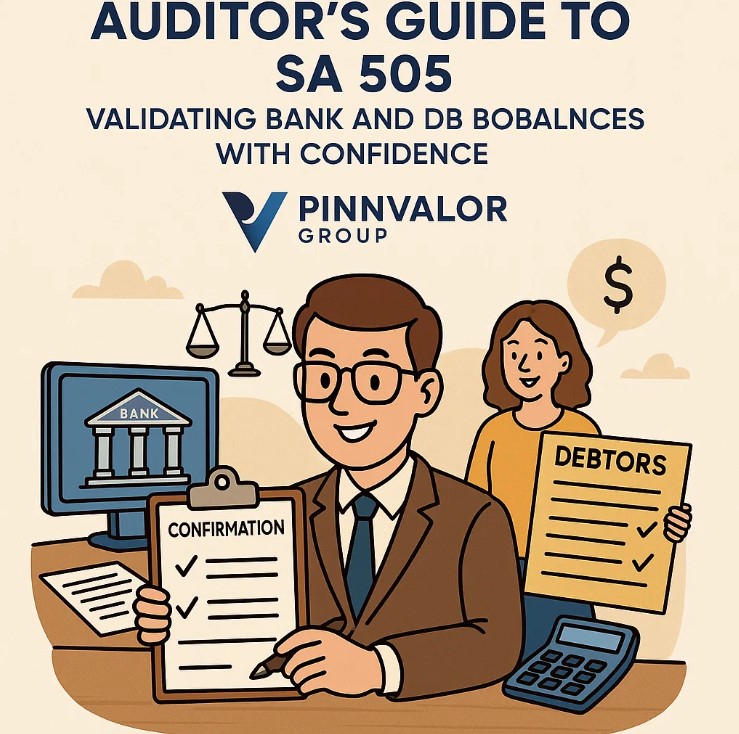
Auditor’s Guide to SA 505: Validating Bank and Debtor Balances with Confidence
When it comes to auditing financial statements, trust is good, but verification is essential. Auditors cannot rely solely on management representations or internal records—independent, third-party evidence is often required to obtain reasonable assurance. That’s where SA 505 – External Confirmations plays a pivotal role.
This standard, issued by the Institute of Chartered Accountants of India (ICAI), outlines the auditor’s responsibilities when using external confirmations to gather audit evidence. Whether it’s validating bank balances, verifying debtor confirmations, or confirming loan agreements, SA 505 enhances audit reliability through independent verification.
Is your audit evidence strong enough without a direct voice from banks and debtors?
A healthy bottom line means nothing if your operations burn cash. Always follow the money—it tells the real story.
What is SA 505?
SA 505 (External Confirmations) establishes principles and procedures for obtaining audit evidence directly from third parties. It applies when the auditor uses external confirmation procedures to obtain audit evidence in accordance with the requirements of other SAs.
External confirmations can be highly persuasive, as they originate from independent and knowledgeable sources, such as banks, customers, legal counsel, or other third parties.
Scope of SA 505
SA 505 applies to confirmation of:
- Bank balances and borrowings
- Trade receivables and payables
- Terms of agreements or contracts
- Investments and securities
- Legal disputes and contingent liabilities
This standard does not apply when the auditor uses confirmation as a technique to test controls rather than to obtain substantive audit evidence.
Key Objectives of SA 505
- To assess the relevance and reliability of external confirmations.
- To design and perform confirmation procedures that are appropriate for the audit objective.
- To evaluate the results and determine whether additional procedures are required in the event of exceptions or non-responses.
Common Confirmation Areas in Audit
1. Bank Balances and Facilities
- Account balances (current, savings, term deposits)
- Overdraft limits and usage
- Bank guarantees or letters of credit
- Loan terms, security, and interest rates
2. Trade Receivables
- The existence and accuracy of balances
- Any disputes or discrepancies
- Payment terms and credit arrangements
3. Legal Confirmations
- Pending litigations
- Assessment of possible outcomes
- Evaluation of provisions and contingencies
Types of External Confirmations
| Type of Confirmation | Description | Reliability |
|---|---|---|
| Positive Confirmation | Requires response whether or not the party agrees with the stated information | High |
| Negative Confirmation | Requires response only if the party disagrees with the stated information | Moderate (used for low-risk accounts) |
| Blank Confirmation | No information is pre-filled; recipient fills in the details | Highest (but lower response rates) |
Auditor’s Responsibilities Under SA 505
1. Design the Request Appropriately
- Ensure it addresses the correct assertion (e.g., existence, rights, accuracy)
- Use clear, concise language
- Customize based on the nature of the item being confirmed
2. Maintain Control Over the Process
- The auditor should send, track, and receive the confirmations directly
- Responses should not pass through the client or management
3. Evaluate Responses Critically
- Match the third party’s response with the client’s records
- Investigate any discrepancies or unusual items
- Assess whether responses appear genuine and complete
4. Handle Non-Responses
- Send a second request
- Apply alternative procedures such as verifying subsequent cash receipts or reviewing ledger entries
- Document the steps taken and evidence obtained

Limitations and Considerations
- Delayed or non-responses can create audit delays
- Email-based confirmations may require additional verification
- Management resistance is a red flag requiring professional skepticism
- Confirmations alone are often not sufficient—must be supported by other procedures
When External Confirmations May Be Inappropriate
- If reliable alternative evidence is available
- Where third parties are unlikely to respond
- When confirmations could compromise confidentiality
In such cases, the auditor must document the justification and perform alternative audit procedures.
Documentation Required Under SA 505
- Design of confirmation procedures
- Rationale for selecting items to confirm
- Responses received and evaluation thereof
- Follow-up actions for non-responses or exceptions
Conclusion
SA 505 empowers auditors to secure audit evidence that is objective, independent, and trustworthy. By diligently applying its principles, auditors reduce audit risk, detect misstatements, and enhance confidence in financial reporting.
